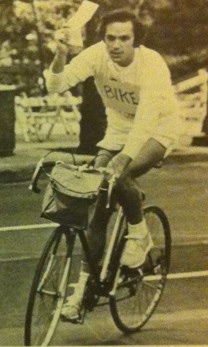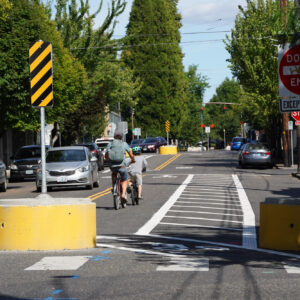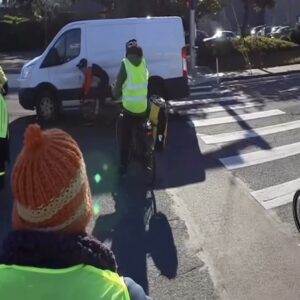
Earl Blumenauer from
a 1979 Multnomah County
newsletter.
– See full version below-
U.S. Congressman Earl Blumenauer has been extolling the virtues of bicycling for a long time — but I didn’t realize just how long.
Far from jumping on the green transportation bandwagon, or simply hitching up to Portland’s bike heydays in the 1990s, Blumenauer has been promoting the use of bicycles in our region for over 30 years.
Yesterday I came across a scan of an old Multnomah County newsletter from May 1979 (below). The subject of the article and photo was a race in downtown Portland held to prove which mode — bus, feet, car or bike — could travel 12 blocks the fastest.
Guess who won?

The photo shows a 31-year old Blumenauer, then a County Commissioner, with fellow commissioner Gladys McCoy.
“The quickest way to get from the Courthouse to the Gill Building,” it reads, “is to ride a bike.”
The final results (distance is about 12 blocks):
- 1) Bike: 9 mins, 28 secs
2) Bus: 14 mins, 59 secs
3) Walk: 15 mins, 21 secs
4) Drive: 16 mins, 23 secs (“proving this is the least efficient and most expensive way to cover the distance.”)
The newsletter said both Blumenauer and McCoy had been, “urging the use of energy-efficient bicycles instead of County-owned motor vehicles.”
Today at 4:30 pm, Oregon Public Broadcasting (our local NPR affiliate station) will revisit this timeless race format. My money is on the bike rider. While it won’t be Blumenauer riding this time, there’s a good chance that whoever is, will rely on bikeways he had a hand in building.




Thanks for reading.
BikePortland has served this community with independent community journalism since 2005. We rely on subscriptions from readers like you to survive. Your financial support is vital in keeping this valuable resource alive and well.
Please subscribe today to strengthen and expand our work.
Do they also track the relative sweatiness/wetness of the participants and suitability for attending a business meeting immediately after using one’s preferred mode of transportation?
Maybe they should include transitions at both ends of travel. Fetching your vehicle at the start and time searching for a parking spot, and walking to a destination point at the end.
I suspect that the Pedestrian will win at 12 blocks.
And the car may take 10 minutes to park. And 5 minutes to walk from the parking spot.
How sweaty can you get when you take over 9 minutes to go 12 (short Portland) blocks?
Do they they also track the relative obesity/fatness of the participants and suitability for attending a business meeting looking like a stereotypical overweight american?
(word play in effect)
My bet is on zero laws broken. If I were to disregard all laws (or simply have no stops or cross traffic to worry about) then I could cover 12 blocks in less than 3 minutes. Nine and a half minutes sure sounds like a law-abiding time to me.
Oops. I meant to reply to Red Five.
do they also track how many laws are broken for the bicycle to make that time?
Some cultural norms might be in need of modification….
Over a few blocks, I’m guessing that if the sun is out at all, the car’s going to be so incredibly hot that you’ll actually be dryer going by bike, even if this were Tulsa in the throes of a hot, muggy summer afternoon.
I doubt most bike commuters (i.e. likely in relatively good shape) will sweat after riding 12 blocks, especially in Portland’s weather.
I’m certain that these helmetless scofflaws ignored stop signs, blew through red lights, and placed pedestrians in mortal danger to win as that is what bikers always do!
But since there were no internets to let bitter people to rant about it, we’ll never know.
I’d think if one were going to a business meeting they’d plan accordingly. I think you’re missing the point of this article. 🙂
It is quite eye-opening to recall all the incredibly useful and creative things governments and our media pursued and profiled in the seventies, how seriously we all took the energy crises back then. It is both inspiring and dispiriting. Inspiring that we were so much more amenable to change all the way up to elected officials and down to folks tinkering in garages in Eugene making bike trailers; dispiriting because those bike trailers are now almost exclusively* made in Asia and we’ve mostly abandoned a serious commitment to change, to overcoming our addiction to oil, in the media and government, not to mention among the populace.
*there are still Oregon-made bike trailers, but Burley’s not one of them: Equinox, Cycle Tote
Back in the 70’s, most people still possessed critical thought and had self-reliance skills. Today in the tech and convenience obsessed world, no one thinks because there are iPhone apps to do that for you, any concept that requires more than 140 characters to explain is boring, and Americans bank on the assumption that some smart engineers will create a new cheap energy source, car that runs on water, etc. in the nick of time so why think about proactively changing our behaviors? America is waiting for Superman. (Apologies to the filmmakers that produced “Waiting for Superman”.)
Ah yes, the 70s were a Golden Age of peace and prosperity.
Brad — I’d suggest that not EVERYONE has stopped thinking for themselves and practicing some form of self-sufficiency. How else do you explain the increase in the number of folks who ride bikes for transportation (at least here in crusty, independent, self-sufficient Portland)?
Not everyone, Beth. Portland is leading in some regards because it thinks differently and because alternative ways of thought are accepted here. 9watts is right about the 70’s and the mentality back then. People drove less, bought fuel efficient vehicles, began riding bikes, turned down the thermostat, wore sweaters, etc. Today it seems that most either believe that peak oil/climate change/energy shortages are a hoax, liberal propoganda, or a problem that can be solved neatly and heroically like a Hollywood movie.
A real energy crisis (or a major natural disaster) will show how weak and useless our population has become without their gizmos and the inability to use their brains or “old” non-electric technology.
Brad, your perception and my memory about the 1970s don’t quite match. True, the oil embargo did move some folks to smaller cars. But they bought those smaller cars to be able to afford driving more. A few folks were banging the sustainability drum, but they were mostly regarded as hippie nutcases by most.And as gas prices dropped, the cars got bigger again. And miles driven increased.
It wasn’t until the City hired a bike coordinator in the early 1990s, The BTAs founding(..not sure which came first, I think the BTA,) that cycling facilities were even seriously discussed beyond recreational only trails.My experience was that cyclists were treated with a much more open hostility by those motorists of the 1970s.
That then Commissioner Blumenauer championed cycling was emblimatic of the shift in the leadership of the city. Post Mt Hood Freeway Portland saw the old ‘top down’ style of city management replaced by the ‘young turks’ like Goldscmidt, Kafoury, Walsh, Gustavson and Strahan championing a grassroots approach to city government. And THAT more than anything changed the discussion. Not gas prices.
Bike boom of the 1970s. http://en.wikipedia.org/wiki/Bike_boom
but it was primarily recreational cycling. Transportation cycling ( which I understand this thread to be focused on) in Portland is a relatively recent thing. Transportation cycling has grown exponentially in the past decade, but was almost nonexistent in the 70s and 80s. Out there there will be a few folk who can say, yeah, I did it in 1988, but they were a very small number, without anybody doing anything to improve their lot and safety.
Now all those old 1970’s road bikes you couldn’t give away 10 years ago are selling like hotcakes, to be turned into fixies..
I would really think that gas prices are affecting that, too, Beth. Once they get below $3/gallon, there will be fewer bikes.
I’m not suggesting its independent thinking as much as policy and groundwork have started the construction of some ( but nowhere near enough) facilities that encourage some folks to ride instead of driving. People have a way of figuring out what works best for them. When one does the time/cost/convenience calculus for their lives, they often figure what works best and goes for it. Among the things that cycling in Portland has going for it is an active, fun bike community that demonstrates that it IS possible, and possible to have some fun on your commute also.
but not everybody has gotten that memo.
This isn’t the first time I’ve been challenged to rethink the adage that a politician is someone who determines which way the parade is going and moves to the front of it.
Good for Blumenauer. Good for Portland.
Not sure if this competition still happens in Portland, but an advocacy group in NYC does it every year. Being New York, though, the competition is between bike, subway, and taxi, and it’s 4.2 miles long. Spoiler: the bike always wins.
http://www.nbcnewyork.com/the-scene/archives/Bike-Still-Trounces-Car-Subway-in-Annual-Commuter-Race.html
http://gothamist.com/2009/05/21/8th_annual_nyc_commuter_race_pits_b.php#photo-1
just that people still think a car is an efficient way to navigate the city boggles my mind… I discovered this on my first drive to San Francisco…
Casey Negreiff and I will be representing the bicycle. I’ll be tweeting about it as @alexmontjohn, as long as it doesn’t slow us down…
Johnson-Negreiff FTW !
I commute between my building and the meetings on our main campus (1.5 mi, tops). I routinely beat the drivers by a good 10 minutes. Then I smirk 🙂
I should mention that I do not break into a sweat either.
Remind me of when I stayed at the Seaside Hostel back in 2001, when I met a guy who was spending some of his retirement living there. He told me that during his working days, around the time of this photo, he commuted by bicycle from St. Helens to Portland every day. When he lived in Southwest Portland, he was a activist for better pedestrian facilities there.
There was a strong undercurrent of progressive, practical transportation advocacy starting in Tom McCall’s day, which has merely peaked in the last few years. Without the work of Blumenauer and others, the political environment we enjoy today could not exist.
Let’s have them go UP pill hill and see who wins. Anyone can glide down, that’s easy.
Something a marshmallow might say. Try thinking “I can” instead of “I can’t.”
it works wonders!
Once you ride a while, hills don’t scare ya. Grab an easy gear and get into the rhythm. Before you know it, you’re there.
Or they can ride the tram.
I regularly bike from our downtown office for meetings at locations within 3 miles. Given the urban context, it really is just as quick. I get exercise, get to enjoy fresh air, and yes, I occasionally arrive with a sheen of perspiration on my brow. Sheesh… have we forgotten that this is normal and natural? I like to think that others gain from seeing this in a business environment.
The City’s SmartTrips program also recreated this “race” for Bike to Work month several years back. We had the Widmer Brothers race from NE Broadway to City Hall. Guess who won? (Click my name to learn the answer!)
Cool article! I love the historical pics.
Did everyone have the Ted Bundy haircut in the 70’s?
Gladys McCoy was a county commissioner, but I don’t believe she ever served on the Portland City Council
Thanks Jim. Made the correction. — JM